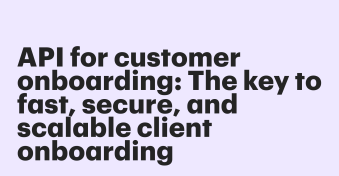It’s no secret that manual processes slow business down for your teams, and we know that every minute counts. They also open the door to costly errors, inconsistent customer experiences, and frustrated clients.
If you’re in RevOps (revenue operations) or are a business leader, you’re probably looking for ways to streamline operations and improve efficiency, right? Well, workflow automation APIs might be the answer.
A workflow automation API can help you create seamless, interconnected workflows that are automatic, instead of being stuck with siloed systems and repetitive manual work. The result is that you have more time for strategic work, fewer errors, and you can scale faster.
In this article, we’ll cover everything you need to know about workflow automation APIs, including what it is, how it saves you money, and the benefits of automating with the right API.
Let’s get into it!
What is a workflow automation API?
A workflow automation API is a tool that allows different software systems to communicate with each other and trigger automated actions based on predefined conditions. Simply put, it connects your tech stack and makes it possible for tasks to happen behind the scenes without the need for manual input at every step.
So, when a sales rep is updating a CRM record, for example, the API can trigger a task for document generation, send a proposal for eSignature, and notify your legal team once it’s all signed. This can happen in a single workflow.
Workflow automation APIs are both convenient and scalable, making processes more reliable as they limit human error and allow your teams to focus their efforts on the higher-value tasks.
With the ability for customization, APIs can also adapt to unique workflows of any business, which could mean automating contract generation, invoice approvals, or customer onboarding.
Bonus: What is document automation API and how does it work?
The hidden costs of manual workflows
Manual processes might seem pretty manageable if your team is on the small side or if your operations aren’t that complex. But your business is going to grow, and that means it will make everything trickier.
Here are the top pain points that can come with relying on a manual workflow:
- Time waste: When you’re repeating the same steps manually, like copying data from one platform to another, your productivity will likely slow down since it is so time consuming. This means less time spent on more strategic endeavors and more burnout, as tasks pile up more quickly.
- Data entry errors: As humans, it’s common to make mistakes. But even just one typo or missed update can cause a delay in a deal, lead to compliance issues, or even damage your business reputation. For many industries, these errors can have serious consequences.
- Delayed workflows: If you are only relying on a human to remember a task, you can guarantee things will slip through the cracks. Delays in contract approvals or customer onboarding will leave customers less satisfied and ultimately hurt your revenue stream. What’s worse? These delays can cause you to miss opportunities and SLAs.
- Inconsistent processes: Without automation, it’s likely team members will be following different steps, which leads to miscommunication, lost information, and a lack of visibility. This means inconsistencies will show up during audits or handoffs between departments.
- Scaling limitations: It’s worth hammering the point home: When your company grows, the complexity of a manual process will skyrocket. Think of going from a team of 10 to a team of 1,000—while it won’t happen overnight, this growth will be difficult to manage if you don’t have automation in place for your workflow.
How workflow automation APIs solve these challenges
Let’s talk about how workflow automation APIs can actually offer a solution to these challenges by standardizing, automating, and scaling your processes.
This is what they can do to help:
- Trigger actions across systems automatically. No more waiting for someone to send a document, follow up, or update the database. Your systems can handle these things themselves in real time with an effective automation API.
- Connect your favorite tools. APIs have the power to integrate your CRM, billing system, document platform, and other software into a single workflow. This means a unified tech stack that provides a higher level of visibility and accuracy across your data.
- Ensure consistency. When workflows are following the same rules every time (because of the API), every customer and prospect will get a better experience.
- Reduce reliance on human memory. Let’s be real, you shouldn’t have to worry about missed steps or forgotten tasks. APIs allow your workflow to essentially run on autopilot so you don’t have to stress about the basics.
Key benefits of workflow automation APIs
Let’s dive a little deeper into the benefits of employing a workflow automation API.
1. Save time and reduce costs
If you automate repetitive, manual tasks, your team will get hours back every week. That time can be better spent closing deals, refining your strategy, or even nurturing existing customer relationships. This is because automation reduces the need for manual oversight, meaning you will lower operational costs at the same time you increase your team’s efficiency.
Take our client, Colonies, for example: By integrating PandaDoc’s API into their platform, they were able to reduce application processing time by 25% by creating an easy, in-app leasing process for their tenants.
“PandaDoc’s API integration has been a transformative tool for Colonies as we continue to scale across new properties and countries. Each lease is automatically tailored to meet regional legal requirements and property specifics, saving countless hours in document preparation and significantly reduced errors. Automating these processes within our platform has not only improved tenant satisfaction but also empowered our team to focus on expanding our reach and enhancing our offerings.”
– Thomas Guillot, VP Digital of Colonies
2. Minimize errors
It’s no secret that mistakes happen when humans are responsible for repetitive data entry or document generation. But when you employ a workflow automation API, it removes that risk by transferring data and triggering actions consistently and accurately across all of your different systems.
When it comes to regulated industries where errors can lead to noncompliance or legal penalties, this is especially important. It becomes about protecting your business from legal fallout.
3. Scale operations with ease
We’ll say it again: your workflows need to grow with you as your business scales, and automation is the way to do that. You don’t necessarily need to hire more staff to manage a growing workload. Instead, you can rely on automation to handle high-volume and repeatable tasks at scale.
A well-integrated API means growing your sales, customer success, and legal operations without necessarily needing an equal increase in headcount. This is useful in rapid growth periods, where you simply can’t onboard that many new employees, let alone need to.
4. Improve compliance and audit readiness
Your processes should follow the same steps every time, especially when you have regulatory requirements. Workflow automation APIs can help with this, plus, they can document who did what and when, which leads to simpler, faster audits.
A standardized workflow through an API means your documentation trail is clear with reliable timestamps. Any compliance data that needs to be pulled quickly and accurately can be.
5. Enhance customer and employee experiences
When you have consistent, timely workflows, your customers will feel the difference. They will notice faster contract turnarounds and an easy onboarding experience. When it comes to internal employees, your teams will feel less strained by admin work and have more time for strategic work.
Our client, Ion Solar achieved 20% faster proposal revisions when they switched to PandaDoc’s document management API. They experienced smoother operations with our solution as they scaled their business, minimizing bottlenecks and enhancing collaboration among their team members.
“Migrating to PandaDoc gave us an edge in our operational efficiency. Don’t let the lesser-known name fool you; PandaDoc delivered more value than its bigger rivals. It’s a robust, reliable solution that transformed our document management process for the better.”
– Brandon Mullen, IT Director at Ion Solar
Bonus: Want to dive deeper? Explore these six benefits of document workflow automation.
What to look for in a workflow automation API
Ready to start looking for a workflow automation API that will work for you? Here are the top things we think you should consider when making your choice:
- Ease of integration: Whatever API you choose should integrate smoothly with your existing systems and tech stack. It will be easier to get started if it supports a wide range of native integrations.
- Clear documentation: It should be easy and quick to understand how to use the API, for both developers and non-developers alike. Solid documentation makes adoption faster and reduces the reliance on engineering.
- Flexibility and customization: Your API needs to allow for tailored workflows so you can have exactly what your business needs. This is necessary regardless of your industry, whether you’re a SaaS provider or a legal firm.
- Security and compliance: The API provider should follow industry best practices for data security and regulatory compliance, which means data encryption, secure authentication, audit trails, etc. PandaDoc, for example, is enterprise-grade and developer-ready with SOC 2 certification. Plus, our API is E-SIGN, UETA, and HIPAA compliant so you can count on secure, legally binding eSignatures.
- Support and reliability: Your API provider should offer strong customer support, a reliable platform, and have proven use cases. You should see a track record of successful implementations before committing.
How PandaDoc’s API helps businesses automate and grow
PandaDoc’s workflow automation API is meant to help you accelerate processes, reduce errors, and scale efficiently. With our API, your teams can:
- Auto-generate personalized documents directly from CRM data
- Trigger eSignature workflows when specific events occur
- Connect PandaDoc to tools like Salesforce, HubSpot, Pipedrive, and more
- Automate approvals, notifications, and document tracking
What does all this mean? Your document management is streamlined from creation to close, all while getting rid of manual inputs. This works for creating quotes, proposals, contracts, and more, so you can do it faster and more accurately.
PandaDoc API reduces friction in the document workflow process with embedded eSigning, sending, and editing so that deals can move forward quickly and smoothly.
Automate now, scale faster
Even if your manual workflows are working now, they probably won’t work forever. When your business grows, you’ll need to count on speed, consistency, and scalability, and a workflow automation API is the answer.
Ready to optimize your document workflow? Start a free 14-day trial today.
FAQ
Can API be used for automation?
Yes. APIs are able to trigger actions automatically between different software systems. This means there’s no need for manual input, which leads to end-to-end workflow automation.
How do I choose the best workflow automation API for my business?
Make sure you look for an API that can integrate well with your current tools, has detailed documentation, allows customization, and provides strong security and support.
How does a workflow automation API improve business efficiency?
APIs eliminate manual repetitive tasks, reduces errors, speeds up processes, and makes sure everything is consistent across workflows. All of this can improve your operational efficiency and help your team grow.

